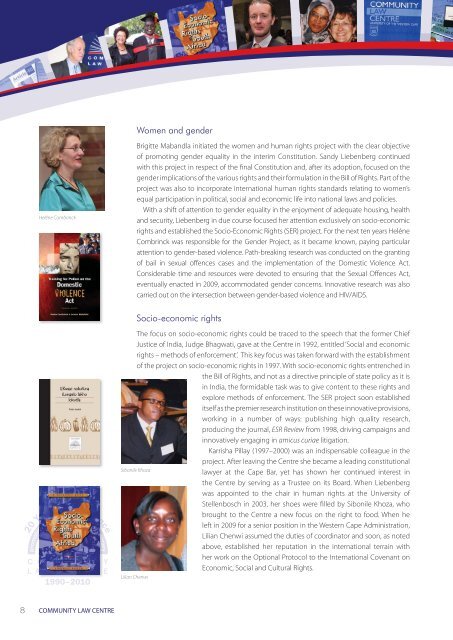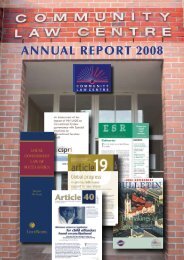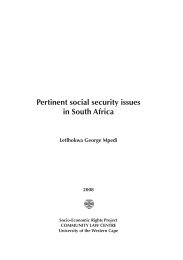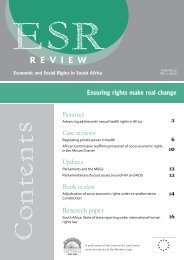printed version - Community Law Centre
printed version - Community Law Centre
printed version - Community Law Centre
- No tags were found...
You also want an ePaper? Increase the reach of your titles
YUMPU automatically turns print PDFs into web optimized ePapers that Google loves.
Women and genderHeléne CombrinckBrigitte Mabandla initiated the women and human rights project with the clear objectiveof promoting gender equality in the interim Constitution. Sandy Liebenberg continuedwith this project in respect of the final Constitution and, after its adoption, focused on thegender implications of the various rights and their formulation in the Bill of Rights. Part of theproject was also to incorporate international human rights standards relating to women’sequal participation in political, social and economic life into national laws and policies.With a shift of attention to gender equality in the enjoyment of adequate housing, healthand security, Liebenberg in due course focused her attention exclusively on socio-economicrights and established the Socio-Economic Rights (SER) project. For the next ten years HeléneCombrinck was responsible for the Gender Project, as it became known, paying particularattention to gender-based violence. Path-breaking research was conducted on the grantingof bail in sexual offences cases and the implementation of the Domestic Violence Act.Considerable time and resources were devoted to ensuring that the Sexual Offences Act,eventually enacted in 2009, accommodated gender concerns. Innovative research was alsocarried out on the intersection between gender-based violence and HIV/AIDS.Socio-economic rightsThe focus on socio-economic rights could be traced to the speech that the former ChiefJustice of India, Judge Bhagwati, gave at the <strong>Centre</strong> in 1992, entitled ‘Social and economicrights – methods of enforcement’. This key focus was taken forward with the establishmentof the project on socio-economic rights in 1997. With socio-economic rights entrenched inthe Bill of Rights, and not as a directive principle of state policy as it isin India, the formidable task was to give content to these rights andexplore methods of enforcement. The SER project soon establisheditself as the premier research institution on these innovative provisions,working in a number of ways: publishing high quality research,producing the journal, ESR Review from 1998, driving campaigns andinnovatively engaging in amicus curiae litigation.Karrisha Pillay (1997–2000) was an indispensable colleague in theproject. After leaving the <strong>Centre</strong> she became a leading constitutionallawyer at the Cape Bar, yet has shown her continued interest inthe <strong>Centre</strong> by serving as a Trustee on its Board. When Liebenbergwas appointed to the chair in human rights at the University ofStellenbosch in 2003, her shoes were filled by Sibonile Khoza, whobrought to the <strong>Centre</strong> a new focus on the right to food. When heleft in 2009 for a senior position in the Western Cape Administration,Lilian Chenwi assumed the duties of coordinator and soon, as notedabove, established her reputation in the international terrain withher work on the Optional Protocol to the International Covenant onEconomic, Social and Cultural Rights.Sibonile KhozaLilian Chenwi8COMMUNITY LAW CENTRE
















